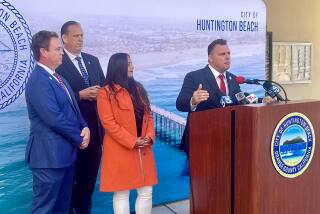Pipeline company to pay more than $60 million for 2015 oil spill near Santa Barbara
- Share via
A pipeline company has agreed to pay more than $60 million, and change its operations, to settle litigation arising from an oil spill that gushed from one of its lines in 2015, north of Refugio State Beach near Santa Barbara, the U.S. Department of Justice said Friday.
The spill dumped roughly 2,934 barrels of crude oil along the Gaviota coast, forced the closure of Refugio and El Capitan state beaches and covered waves, rocky shores, sandy beaches and kelp forests with oil. Hundreds of sea birds and mammals, many coated in crude, washed up in the area in the weeks following the spill.
According to a Justice Department news release, the spill was caused by the company’s failure to address external corrosion and have proper procedures place in its control room. In addition, the environmental damage was “further exacerbated by [the company’s] failure to respond properly to the release,” the department said.
The operator of an underground pipeline that ruptured and released up to 105,000 gallons of crude oil in Santa Barbara County -- and tens of thousands of gallons into the ocean -- said Wednesday that the spill happened after a series of mechanical problems caused the line to be shut down.
Under the settlement, Plains All American Pipeline L.P. and Plains Pipeline L.P. agreed to modify operations to prevent further spills, and to pay $24 million in penalties, plus $22.325 million in natural resource damages, $10 million for natural resource damage assessment costs and $4.26 million for Coast Guard cleanup costs.
The total costs exceed $60 million, the Justice Department said, “excluding the value of the required injunctive relief changes to Plains’ national operations.”
“Today’s settlement shows federal and local governments working in partnership to hold industry fairly accountable,” said Deputy Assistant Atty. Gen. Bruce Gelber of the Justice Department’s Environment and Natural Resources Division. “The agreement will also promote public health and safety, and protect the environment for local communities.”
The Justice Department said it worked closely with its co-plaintiff, the state of California, on behalf of federal agencies including the Pipeline and Hazardous Materials Safety Administration; the Department of the Interior; the Department of Commerce; the National Oceanic and Atmospheric Administration; and the U.S. Coast Guard.
In a statement, Plains said it takes “very seriously” its responsibility to safely deliver energy products.
“This Consent Decree represents a significant step and is the culmination of collaborative discussions with federal and state agencies over the course of a multi-year period, said Brad Leone, director of communications and public affairs for Plains All American Pipeline. “The consent decree sets forth certain improvement actions that we are implementing into our operations.”
After a four-month trial in 2018, a jury found Plains had knowingly caused or “or should have known” that it caused the spill. It also found the company guilty of knowingly filing a false or misleading report to the state.
In a statement at the time, Santa Barbara County Dist. Atty. Joyce E. Dudley described the case as a “David vs. Goliath” battle against a large firm with teams of lawyers and thanked prosecutors for being “relentless in seeking justice for our people, our animals and our environment.”
Friday’s settlement comes at a time when environmentalists are facing an executive order President Trump signed in 2017 to consider new offshore drilling in federal waters off Southern California and around the country.
“This settlement is a poignant reminder of the need to end oil drilling offshore and in our neighborhoods,” Katherine Pease, director of science and policy at Heal The Bay, “in order to prevent further harm to the environment and our health.”
Local opposition to oil drilling was fueled by televised images in 1969 of oil-drenched birds and frantic cleanup crews after a drill boring in federal waters punctured a high-pressure pocket of petroleum.
An estimated 80,000 to 100,000 barrels of crude spewed uncontrolled from the breach into the blue Pacific, much of it congealing into a foot-thick mat. Part of the oil was pushed southwest by winds to San Miguel Island, and the rest was carried by currents toward Santa Barbara.
The event galvanized public awareness of the environment and support for tighter regulatory control of the oil industry. In the 1980s and ’90s, it played a role in defeating efforts by the Reagan administration and later by the first Bush administration to sink more oil wells along stretches of the California coastline, including Monterey Bay.







